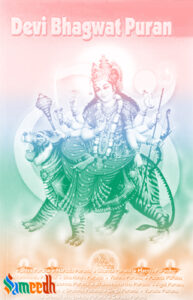The Devi Bhagavat Puran, also known simply as the Devi Puran, is one of the major Purans in Hinduism. Purans are ancient Hindu texts that contain a wide range of narratives, teachings, and mythological stories. The Devi Bhagavat Puran, in particular, focuses on the divine feminine aspect of the Supreme Being, primarily centered around the goddess Devi or Shakti.

The Devi Bhagavat Puran is dedicated to the worship of the goddess Shakti, who is considered the supreme divine feminine power in Hinduism. Devi is often depicted as the mother goddess, encompassing various forms and attributes, including Durga, Lakshmi, Saraswati, Kali, and others.
The origin and authorship of the Devi Bhagavat Puran are not definitively known, as is the case with many ancient Hindu scriptures. However, traditionally, it is attributed to the sage Vyasa, who is also credited with compiling the major Purans and the Mahabharat. Scholars suggest that the Devi Bhagavat Puran was likely composed during the medieval period, possibly between the 9th and 14th centuries CE.
Like other Purans, the Devi Bhagavat Puran contains cosmological narratives explaining the creation of the universe, the origin of gods and goddesses, and the cycle of existence. It presents Devi as the primal energy from which the universe emerges and evolves.
Alongside the narrative sections, the Devi Bhagavat Puran also includes philosophical discussions and teachings on topics such as devotion, karm, dharm (righteousness), liberation (moksh), and the nature of reality. It emphasizes the importance of devotion to the goddess as a means of spiritual attainment.
The Devi Bhagavat Puran holds significant importance in Hindu theology and spirituality, particularly within the Shakta tradition, which reveres Devi as the ultimate reality and source of all creation. It serves as a guide for devotees seeking to deepen their understanding of the divine feminine and cultivate a relationship with the goddess through prayer, meditation, and rituals.
Legends and Stories of Devi Bhagavat Puran
The Devi Bhagavat Puran is rich with numerous legends and stories that highlight the divine exploits, virtues, and manifestations of the goddess Devi (also known as Shakti or Durga). Here are a few notable legends and stories from the Devi Bhagavat Puran:
- Slaying of Mahishasur: One of the most famous stories in the Devi Bhagavat Puran is the tale of Devi’s battle with the buffalo demon Mahishasur. Mahishasur had gained immense power through a boon from Brahma, which made him invincible against all male beings. With his tyranny threatening the universe, the gods sought Devi’s help. In response, Devi manifested as Durga and engaged in a fierce battle with Mahishasur, ultimately slaying him and freeing the world from his oppression.
- Chand and Mund: Another prominent story in the Devi Bhagavat Puran is the confrontation between Devi and the demon brothers Chand and Mund. These demons were sent by the demon kings Shumbh and Nishumbh to defeat Devi. However, Devi, in her fierce form, annihilated Chand and Mund, displaying her power and strength.
- Killing of Raktabija: The story of Raktabija highlights another battle of Devi against a powerful demon. Raktabija had the ability to multiply himself from every drop of his blood that fell to the ground, making him nearly invincible. Devi, in her form as Kali, engaged in a ferocious battle with Raktabija. She overcame him by drinking his blood and preventing it from touching the ground, thus defeating him and ending his reign of terror.
- Sati’s Sacrifice and Shiv’s Grief: The Devi Bhagavat Puran also narrates the tragic story of Sati, the first wife of Lord Shiv, and her sacrifice. Sati’s father, Daksh, insulted Shiv, which caused Sati to immolate herself in grief and anger. This event led to Shiv’s profound grief and rage, resulting in the destruction of Daksh’s sacrifice and the subsequent events leading to the rebirth of Sati as Parvati.
- Devi’s Emergence from the Trinity: The Puran describes how Devi emerged from the combined energies of the trinity of Brahma, Vishnu, and Shiv. She appears as a radiant being, embodying the divine feminine energy that sustains and nourishes the universe.
These are just a few of the many legends and stories found in the Devi Bhagavat Puran that illustrate the power, compassion, and divine attributes of the goddess Devi. Each story serves to deepen the devotee’s understanding and reverence for the supreme feminine principle in Hindu mythology and spirituality.